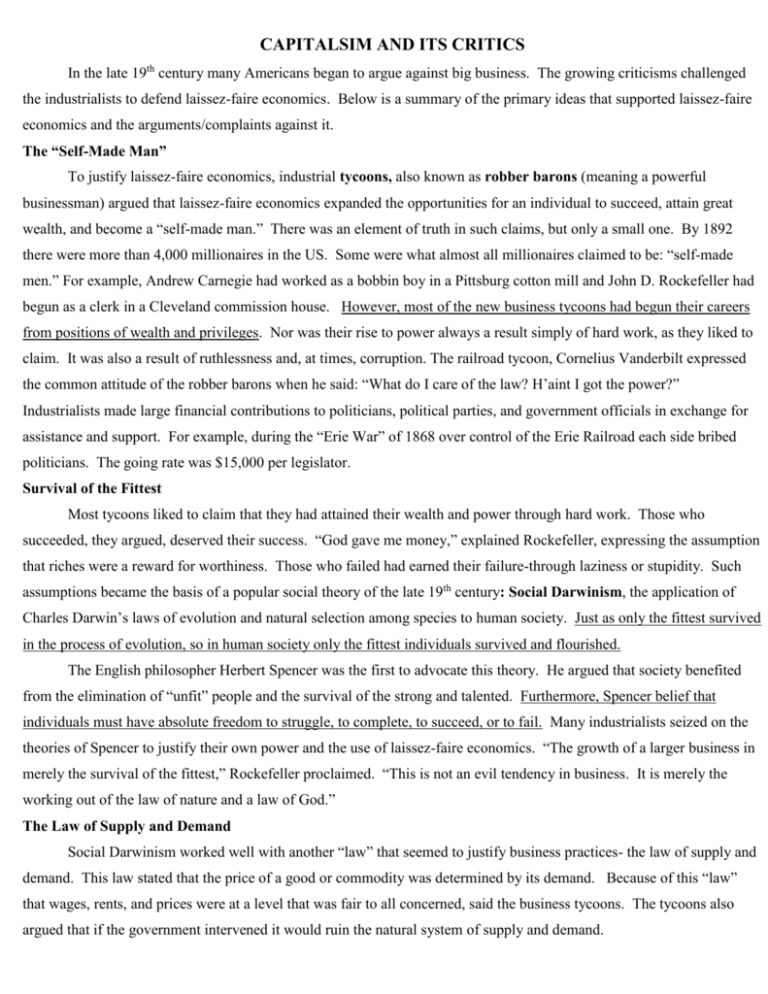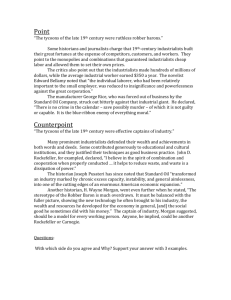CAPITALSIM AND ITS CRITICS
advertisement

CAPITALSIM AND ITS CRITICS In the late 19th century many Americans began to argue against big business. The growing criticisms challenged the industrialists to defend laissez-faire economics. Below is a summary of the primary ideas that supported laissez-faire economics and the arguments/complaints against it. The “Self-Made Man” To justify laissez-faire economics, industrial tycoons, also known as robber barons (meaning a powerful businessman) argued that laissez-faire economics expanded the opportunities for an individual to succeed, attain great wealth, and become a “self-made man.” There was an element of truth in such claims, but only a small one. By 1892 there were more than 4,000 millionaires in the US. Some were what almost all millionaires claimed to be: “self-made men.” For example, Andrew Carnegie had worked as a bobbin boy in a Pittsburg cotton mill and John D. Rockefeller had begun as a clerk in a Cleveland commission house. However, most of the new business tycoons had begun their careers from positions of wealth and privileges. Nor was their rise to power always a result simply of hard work, as they liked to claim. It was also a result of ruthlessness and, at times, corruption. The railroad tycoon, Cornelius Vanderbilt expressed the common attitude of the robber barons when he said: “What do I care of the law? H’aint I got the power?” Industrialists made large financial contributions to politicians, political parties, and government officials in exchange for assistance and support. For example, during the “Erie War” of 1868 over control of the Erie Railroad each side bribed politicians. The going rate was $15,000 per legislator. Survival of the Fittest Most tycoons liked to claim that they had attained their wealth and power through hard work. Those who succeeded, they argued, deserved their success. “God gave me money,” explained Rockefeller, expressing the assumption that riches were a reward for worthiness. Those who failed had earned their failure-through laziness or stupidity. Such assumptions became the basis of a popular social theory of the late 19th century: Social Darwinism, the application of Charles Darwin’s laws of evolution and natural selection among species to human society. Just as only the fittest survived in the process of evolution, so in human society only the fittest individuals survived and flourished. The English philosopher Herbert Spencer was the first to advocate this theory. He argued that society benefited from the elimination of “unfit” people and the survival of the strong and talented. Furthermore, Spencer belief that individuals must have absolute freedom to struggle, to complete, to succeed, or to fail. Many industrialists seized on the theories of Spencer to justify their own power and the use of laissez-faire economics. “The growth of a larger business in merely the survival of the fittest,” Rockefeller proclaimed. “This is not an evil tendency in business. It is merely the working out of the law of nature and a law of God.” The Law of Supply and Demand Social Darwinism worked well with another “law” that seemed to justify business practices- the law of supply and demand. This law stated that the price of a good or commodity was determined by its demand. Because of this “law” that wages, rents, and prices were at a level that was fair to all concerned, said the business tycoons. The tycoons also argued that if the government intervened it would ruin the natural system of supply and demand. The Gospel of Wealth Some businessmen tried to justify their actions in creating monopolies and using ruthless business techniques by using the gospel of wealth. People of great wealth, advocates of this idea argued, had not only great power but great responsibilities. It was their duty to use their riches to advance social progress. Andrew Carnegie elaborated on the idea in his 1901 book The Gospel of Wealth, in which he wrote that the wealthy should consider all money in excess of their own needs as “trust funds” to be used for the good of the community. Carnegie was only one of the many great industrialists who devoted large parts of their fortunes to philanthropic works—much of it to libraries and schools, institutions he believed would help the poor to help themselves. The Problems of Monopoly By the end of the 1800s a growing number of people were becoming deeply concerned about a particular, glaring aspect of capitalism: the growth of monopoly (control of the market by large corporations). They blamed monopolies for creating artificially high prices and for producing a highly unstable economy. In the absence of competition (which was necessary for supply and demand to work), monopolistic industries could charge whatever prices they wished; railroads, in particular, charged very high rates along some routes because, in the absence of competition, they knew their customers had no choice to pay them. Hostility to monopoly was based on more than a concern about prices. Many Americans considered monopoly dangerous because the rise of large combinations seemed to threaten the ability of individuals to advance in the world. If a single person, or a small group, could control all economic activity in an industry, what opportunities would be left for others? To men, in particular, monopoly threatened the ideal of the wage-earning husband capable of supporting his family and prospering, because combinations seemed to reduce opportunities to succeed—to make less likely the idea of the “self-made man.” Adding to the resentment of monopoly was the emergence of a new class of enormously wealthy people. According to one estimate early in the century, 1 % of the families in America controlled nearly 88% of the nation’s assets. Some of the wealthy- Andrew Carnegie-lived well, but not ostentatiously and donated large sums of money to charities. Others, however, lived in grotesque luxury. The Vanderbilts, for example, had seven mansions on seven blocks of New York cities 5th Avenue. Observing their displays of wealth were the four-fifths of American people who lived modestly, and at least 10 million people who lived below the commonly accepted line of poverty. The standard of living was rising for everyone, but the gap between the rich and poor was increasing. Wages and Working Conditions At the turn of the century the average income of the American worker was $400-$500 a year- below the $600 figure widely considered the minimum for a reasonable level of comfort. Nor did workers have much job security. All workers were vulnerable to the boom-and-bust cycle of the industrial economy, and some lost their jobs because of technological advances or because of the cyclical or seasonal nature of their work. Even those who kept their jobs could find their wages suddenly and substantially cut in hard times. Few workers, in other works were very far from poverty. Furthermore, many worked in appallingly unsafe or unhealthy factories. Industrial accidents were frequent and severe. Compensation to the victims was often limited.








